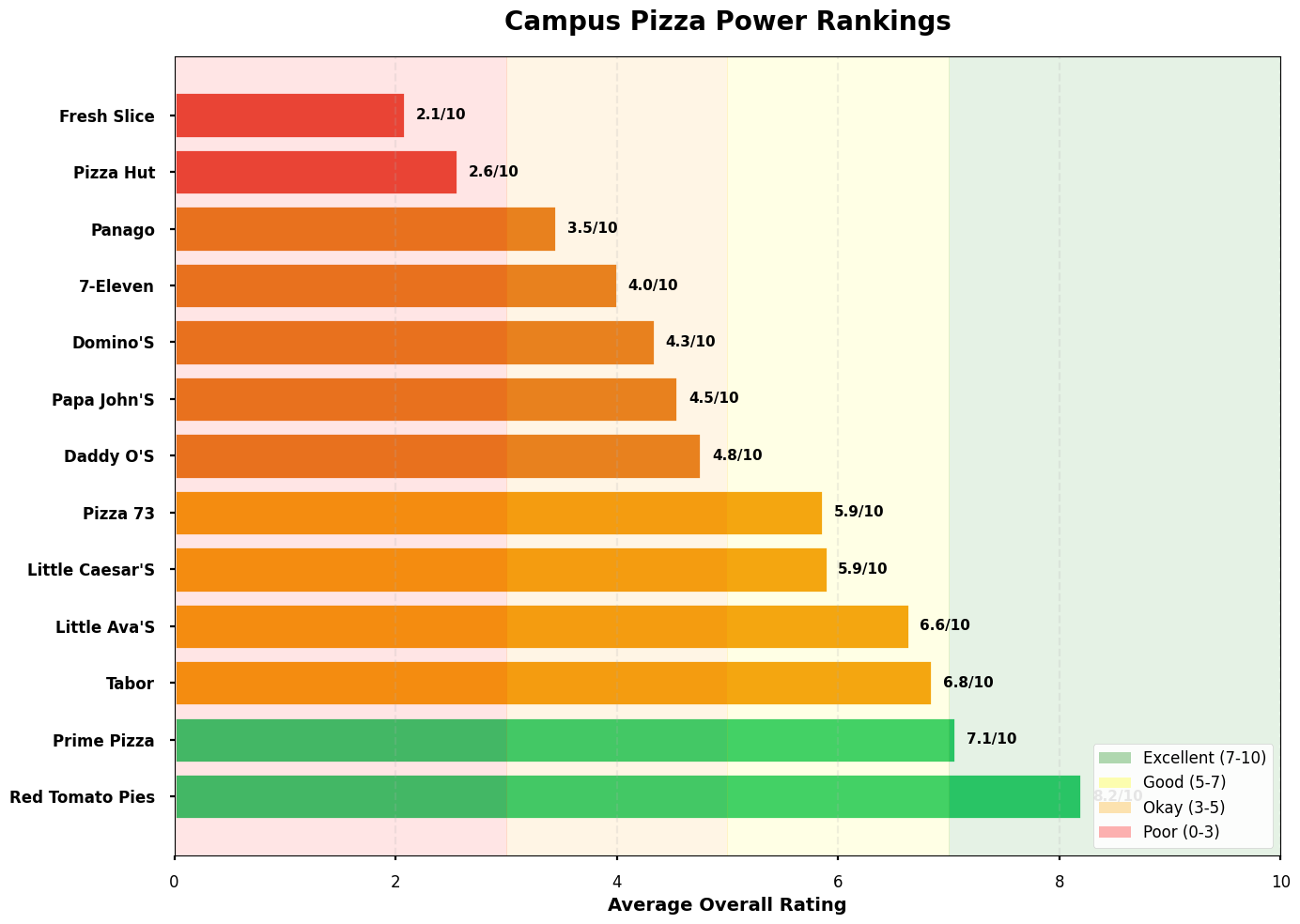Introduction
Following our successful investigations into chicken tenders and burgers, our intrepid team of student taste-testers has turned its attention to perhaps the most sacred of all campus foods: pizza. Late-night study sessions, weekend hangouts, and post-exam celebrations all revolve around this circular beacon of hope. But in a town saturated with pizza options, which establishment truly deserves your hard-earned student dollars?
Armed with scoring sheets, empty stomachs, and a commitment to scientific rigor that would make our statistics professors proud, we embarked on a two-day odyssey across 13 pizza establishments. Our mission: to definitively crown the pizza champion of our campus community.
Methodology
The Test Parameters
To ensure scientific validity and minimize variables, we established strict testing protocols:
Pizza Type: Pepperoni only – the universal standard across all establishments
Crust: Regular crust (no specialty options like stuffed or thin crust)
Size: Smallest regular size available or single slices where applicable
No Modifications: No extra toppings or special requests
No Dipping Sauces: Pizzas were evaluated on their own merits, sans garlic sauce or ranch
The Evaluation Team
Our panel consisted of 4-5 dedicated student tasters who bravely consumed pizza for two consecutive evenings. All pizzas were picked up during evening hours and evaluated within 20 minutes of purchase to ensure optimal temperature and freshness.
Scoring Criteria
Each pizza was meticulously evaluated on four key metrics using a 1-10 scale:
Cheesiness: The quality, quantity, and melt factor of the cheese
Doughiness: Crust texture, flavor, and structural integrity
Meatiness: Pepperoni distribution, flavor, and quality
Overall: The harmonious integration of all elements
Notable Exclusions
Several establishments were excluded from our study:
Tim Hortons and Costco: Their flatbread offerings, while tasty, didn’t meet our definition of traditional pizza
Local Pubs: These establishments exist primarily as bars/social spaces rather than dedicated pizza purveyors
Non-pizza chains: We focused exclusively on restaurants where pizza is the primary product
Findings
The Champions Emerge
After two grueling days of consumption and calculation, Red Tomato Pies emerged victorious with an impressive 8.2/10 overall rating, earning a well-deserved A+ grade. Their pizza excelled across all metrics, with particularly high marks for cheesiness (scoring 0.89 correlation with overall satisfaction).
Prime Pizza secured a respectable second place with 7.1/10, followed by Tabor at 6.8/10. These top performers demonstrated that quality pizza doesn’t have to break the bank – Red Tomato Pies offered excellent value at just $0.263 per gram.
The Correlation Conundrum
Our statistical analysis revealed fascinating insights about what makes students love their pizza. Cheesiness showed the strongest correlation with overall satisfaction (0.89), followed closely by meatiness (0.87) and doughiness (0.86). This holy trinity of pizza perfection suggests that excellence requires mastery of all components – you can’t just pile on cheese and call it a day.
Value Propositions
The value analysis revealed some surprising winners and losers:
Best Overall Value: 7-Eleven, despite its mediocre 4.0/10 taste rating, offered the best price per gram at $0.144
Premium Quality Zone: Red Tomato Pies and Prime Pizza occupied the sweet spot of high quality at reasonable prices
Avoid Zone: Pizza Hut landed squarely in the danger zone – low quality (2.6/10) at mid-range prices ($0.402/gram)
Expensive But Good: Tabor commanded premium prices ($0.531/gram) but delivered decent quality (6.8/10)
The Bottom Dwellers
Fresh Slice and Pizza Hut brought up the rear with abysmal scores of 2.1/10 and 2.6/10 respectively. These pizzas failed across all metrics, proving that proximity to campus doesn’t guarantee quality.
Limitations and Considerations
It’s important to note several limitations of our study:
Timing: All pizzas were picked up during evening hours, which may not represent peak quality times
Limited Scope: We tested only pepperoni pizzas – specialty pizzas might yield different results
No Delivery: We focused on pickup only, which doesn’t account for delivery degradation
Sauce Prohibition: Our no-dipping-sauce rule may have disadvantaged establishments that rely on condiments to enhance their offerings
Furthermore, by day two, several testers reported “pizza fatigue,” a phenomenon where the mere sight of another slice induced existential dread. This may have influenced later scores, though we randomized the testing order to minimize bias.
The Bigger Picture
What our data ultimately reveals is a pizza landscape of stark contrasts. The correlation matrix shows that students value balance – a pizza that excels in one area but fails in others won’t achieve greatness. The 95-gram slices from 7-Eleven might fill you up for cheap, but at what cost to your taste buds and dignity?
Meanwhile, the premium establishments prove that you don’t always get what you pay for. Tabor’s high prices didn’t translate to proportional quality increases, while Red Tomato Pies delivered excellence without requiring a student loan.
Conclusion
After 13 pizzas, countless antacids, and rigorous statistical analysis, Red Tomato Pies seems to have emerged as something that a consensus can be made on. Their combination of superior taste, reasonable pricing, and consistent quality across all metrics makes them the clear choice for discerning students.
However, context matters. If you’re broke and desperate at 2 AM, 7-Eleven’s value proposition suddenly becomes more appealing.
Our advice? Use our comprehensive data to make informed decisions. The correlation matrix tells us that good pizza is about harmony, not extremes. The value matrix reminds us that price doesn’t always equal quality. And the report card gives you the quick reference you need when hunger strikes and decision paralysis sets in.
Remember, this study reflects only pepperoni pizzas picked up during evening hours. Your mileage may vary with different toppings, times, or dining experiences. But armed with our data, you’re now equipped to navigate the complex pizza ecosystem of our campus community.









